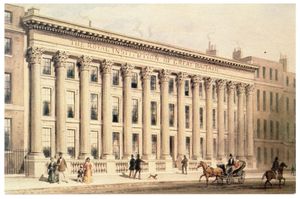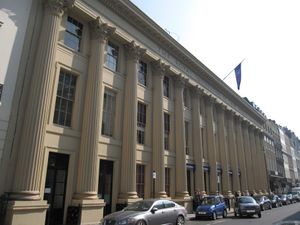المعهد الملكي لبريطانيا العظمى
(تم التحويل من الهيئة الملكية)
المعهد الملكي لبريطانيا العظمى Royal Institution of Great Britain هي منظمة مكرسة للتعليم العلمي والبحثي، ومقرها في لندن.
مقدمة
التاريخ
حائزون على جائزة نوبل
- John William Strutt, 3rd Baron Rayleigh (1842–1919) - Physics 1904 with William Ramsey for the discovery of Argon
- Joseph John Thomson (1856–1940) - Physics 1906 for studies of electrical connection through gases
- Ernest, Baron Rutherford of Nelson (1871–1937) - Chemistry 1908 for work on the chemistry of radioactive substances and the disintegration of the elements
- William Lawrence Bragg (1890–1971)- Physics 1915 joint with WH Bragg, for determining the molecular structure of crystals using x-rays
- William Henry Bragg (1862–1942)- Physics 1915 joint with WL Bragg, for determining the molecular structure of crystals using x-rays
- Charles Scott Sherrington (1857–1952) - Chemistry 1932 shared, for his discovery of the function of neurons
- Henry Hallett Dale (1875–1968) - Medicine 1936 joint with Otto Loewi, for their work on the chemical transmission of nerve impulses[1]
- Peter Brian Medawar (1915–1987) - Medicine 1960 for his work on making permanent skin grafts
- John Cowdery Kendrew (1917–1997) - Chemistry 1962 with Perutz, for determining the structures of haemoglobin and myoglobin using X-ray crystallography and (new at the time) electronic computers
- Max Ferdinand Perutz (1914–2002) - Chemistry 1962 with Kendrew, for determining the structures of haemoglobin and myoglobin using X-ray crystallography and (new at the time) electronic computers
- Andrew Fielding Huxley (1917–2012) - Medicine 1963 for explaining how nerves use electricity to send signals around the body
- Dorothy Crowfoot Hodgkin (1910 – 1994) - Chemistry 1964 for determining the structure of important biochemical substances including vitamin B12 and penicillin using X-ray techniques
- George, Baron Porter of Luddenham (1920–2002) - Chemistry 1967 for work on chemical reactions triggered by light, and for photographing the behaviour of molecules during fast reactions
- Anthony Hewish (1924-) - Physics 1974 for his work on the discovery of pulsars
- Sir John Gurdon (1933-) - in 2012, he and Shinya Yamanaka were awarded the Nobel Prize for Physiology or Medicine for the discovery that mature cells can be converted to stem cells
العناصر الكيميائية
- Potassium – isolated from caustic potash by Humphry Davy in 1807 using electrolysis.
- Sodium – Humphry Davy first isolated sodium in 1807 from molten sodium hydroxide.
- Barium – isolated by electrolysis of molten barium salts by Humphry Davy in 1808.
- Boron – discovered by Humphry Davy who first used electrolysis to produce a brown precipitate from a solution of borates in 1808. He produced enough of the substance to identify it as an element but it wasn't until 1909 that pure boron was produced.
- Calcium – isolated by Humphry Davy in 1808 from a mixture of lime and mercuric oxide using electrolysis.
- Chlorine – Elemental chlorine was discovered in 1774 but was thought to be a compound and was called "dephlogisticated muriatic acid air". Humphry Davy named it Chlorine in 1810 after experimenting with it and declared it was an element.
- Magnesium – first produced/discovered in 1808 by Humphry Davy using electrolysis of a mixture of magnesia and mercury oxide.
- Strontium – known in mineral form but isolated as an element in 1808 by Humphry Davy from a mixture of strontium chloride and mercuric acid.
- Iodine – Discovered by Bernard Courtois in 1811, he lacked the resources to investigate the substance but gave samples to various researchers. It was named by Joseph Louis Gay-Lussac who thought it either a compound of oxygen or an element. A few days later Humphry Davy stated it was a new element leading to wrangling between the two over who identified it first.
- Argon – discovered in 1894 by Lord Rayleigh and William Ramsey.
الرؤساء
Since 1799, the Royal Institution has had fifteen Presidents and one Acting-President.[2]
- 1799 - George Finch, 9th Earl of Winchilsea
- 1813 - George John Spencer, 2nd Earl Spencer
- 1825 - Thomas Pelham, 2nd Earl of Chichester
- 1827 - Edward Adolphus Seymour, 11th Duke of Somerset
- 1842 - Algernon Percy, 4th Duke of Northumberland
- 1865 - Sir Henry Holland, 1st Baronet
- 1873 - Algernon George Percy, 6th Duke of Northumberland
- 1899 - Henry George Percy, 7th Duke of Northumberland
- 1918 - Alan Ian Percy, 8th Duke of Northumberland
- 1930 - Lord Eustace Percy, later (1953) raised to the peerage as 1st Baron Percy of Newcastle
- 1945 - Robert John Strutt, 4th Baron Rayleigh
- 1948 - John Theodore Cuthbert Moore-Brabazon, 1st Baron Brabazon of Tara
- 1963 - Alexander Fleck, 1st Baron Fleck
- 1968 - William Wellclose Davis (acting)
- 1969 - Harold Roxbee Cox, Baron Kings Norton
- 1976 - Prince Edward, Duke of Kent
المديرون
 مقالة مفصلة: إدارة المعهد الملكي
مقالة مفصلة: إدارة المعهد الملكي
جدل اندرادي
جدل گرينفيلد
متحف فاراداي
قناة ري
المعهد الملكي في استراليا
انظر أيضاً
المصادر
- ^ "The Nobel Prize in Physiology or Medicine 1936". www.nobelprize.org. Retrieved January 30, 2013.
{{cite web}}: Italic or bold markup not allowed in:|publisher=(help) - ^ RI Presidents since 1799, Royal Institution website, accessed 26 February 2011
وصلات خارجية
الكلمات الدالة:
This article may include material from Wikimedia licensed under CC BY-SA 4.0. Please comply with the license terms.
تصنيفات:
- CS1 errors: markup
- Pages using gadget WikiMiniAtlas
- Pages using div col with unknown parameters
- Coordinates on Wikidata
- منشأت بريطانيا العظمى في 1799
- معهد ملكي
- جمعيات علمية
- التعليم في لندن
- علوم وتكنولوجيا في المملكة المتحدة
- جمعيات علمية في المملكة المتحدة
- متاحف العلوم في المملكة المتحدة
- متاحف السيرة الذاتية في المملكة المتحدة
- منظمات الرعاية الملكية السامية مقرها في لندن
- متاحف في وستمنستر
- منظمات تأسست في عام 1799
- Grade I listed scientific buildings
- Grade I listed buildings in London
- Lewis Vulliamy buildings
- منشأت في انگلترا في 1799
- علوم وتكنولوجيا في لندن
- متاحف العلوم في إنگلترا
- Biographical museums in London


